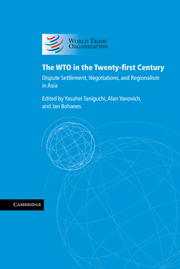Book contents
- Frontmatter
- Contents
- Notes on contributors
- Acknowledgements
- Table of dispute settlement cases and reports
- List of abbreviations
- Introduction
- PART I The WTO at Ten
- PART II Accomplishments and Future Prospects of the WTO Dispute Settlement System
- 3 The WTO dispute settlement system after ten years: the first decade's promises and challenges
- 4 WTO dispute settlement practice 1995–2005: lessons from the past and future challenges
- 5 Evaluating WTO dispute settlement: what results have been achieved through consultations and implementation of panel reports?
- 6 The responsibilities of a WTO Member found to have violated WTO law
- 7 ‘Public–private partnerships’ in WTO dispute settlement: the US and EU experience
- 8 Accomplishments of the WTO dispute settlement mechanism
- 9 Arbitration as an alternative to litigation in the WTO: observations in the light of the 2005 banana tariff arbitrations
- 10 The evolving WTO dispute settlement system
- PART III Asian Perspectives on WTO Dispute Settlement
- PART IV The Doha Development Agenda and Beyond
- PART V Asian Regional Integration and the Multilateral Trading System
- Index
6 - The responsibilities of a WTO Member found to have violated WTO law
from PART II - Accomplishments and Future Prospects of the WTO Dispute Settlement System
Published online by Cambridge University Press: 05 March 2012
- Frontmatter
- Contents
- Notes on contributors
- Acknowledgements
- Table of dispute settlement cases and reports
- List of abbreviations
- Introduction
- PART I The WTO at Ten
- PART II Accomplishments and Future Prospects of the WTO Dispute Settlement System
- 3 The WTO dispute settlement system after ten years: the first decade's promises and challenges
- 4 WTO dispute settlement practice 1995–2005: lessons from the past and future challenges
- 5 Evaluating WTO dispute settlement: what results have been achieved through consultations and implementation of panel reports?
- 6 The responsibilities of a WTO Member found to have violated WTO law
- 7 ‘Public–private partnerships’ in WTO dispute settlement: the US and EU experience
- 8 Accomplishments of the WTO dispute settlement mechanism
- 9 Arbitration as an alternative to litigation in the WTO: observations in the light of the 2005 banana tariff arbitrations
- 10 The evolving WTO dispute settlement system
- PART III Asian Perspectives on WTO Dispute Settlement
- PART IV The Doha Development Agenda and Beyond
- PART V Asian Regional Integration and the Multilateral Trading System
- Index
Summary
I admire the achievements of panels and the Appellate Body, and of the unsung heroes who assist them behind the scenes. Over the past decade, they have succeeded in developing a coherent jurisprudence and in maintaining the support of the membership of the World Trade Organization (WTO) for the dispute settlement system. However, when evaluating the performance of the WTO dispute settlement system, one should not only examine how panels and the Appellate Body handled the complaints that were actually submitted to them. An evaluation of that system is only complete if it comprises also an analysis of the complaints that Members did not bring. The focus of this chapter is on one feature of the WTO dispute settlement system that has prevented Members from resorting to that system to assert their rights in many situations.
The statutes of international tribunals generally do not contain rules limiting the tribunal's right to determine the responsibilities of a State found to have committed a wrongful act. Thus, the Statute of the International Court of Justice (ICJ) does not impose any such limitation; nor did the procedures followed by the panels established under the General Agreement on Tariffs and Trade (GATT) 1947. The Understanding on Rules and Procedures Governing the Settlement of Disputes (DSU) of the WTO is an exception. Article 19.1 of the DSU provides:
Where a panel or the Appellate Body concludes that a measure is inconsistent with a covered agreement, it shall recommend that the Member concerned bring the measure into conformity with that agreement. (Footnotes omitted)
- Type
- Chapter
- Information
- The WTO in the Twenty-first CenturyDispute Settlement, Negotiations, and Regionalism in Asia, pp. 141 - 147Publisher: Cambridge University PressPrint publication year: 2007

